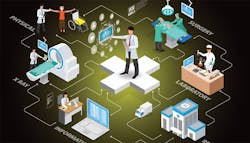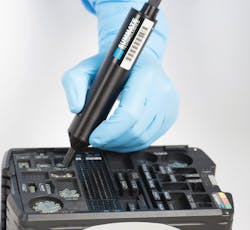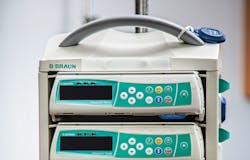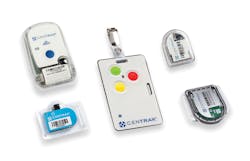In the film Ford v. Ferrari the American and Italian automakers battled for supremacy in the boardrooms, development and engineering labs and on the racetracks – most notably during the celebrated 24 Hours of LeMans competition in France in 1966.
In the adoption and implementation race for tracking capabilities, bar coding and radiofrequency identification (RFID) continue to accelerate among providers and suppliers in the warehouses, storerooms, patient rooms, hallways and transport vehicles.
While both technologies have been available for decades – bar coding for at least twice as long as RFID – the healthcare industry still affords room for growth either in dedicated or specialized areas or across the enterprise.
Short of committing all-in to one technology for every tracking need throughout an organization, how and where might an organization decide to pursue?
Healthcare Purchasing News reached out to nearly 20 suppliers of bar coding and RFID technology to assess and evaluate the roles and contributions of either technology in four key tracking areas: People (e.g., patients, staff, visitors), products in bulk (in the storeroom or warehouse), products in low units of measure (on the shelves in the storeroom, patient room or supply closet) and reusable devices and equipment (shared by clinicians and assigned to patients). HPN asked them to mull over which was more effective, efficient, popular and useful – four characteristics with varying applications, definitions and justifications.
Some might anticipate the newer technology, RFID, squeaking out in the lead position over the aging stalwart bar coding, but experts really lean toward balance and parity based on application and functionality, which should settle as good news to fans of either tracking modality.
Setting the stage
“Moving forward, we can expect that solutions will not necessarily be exclusively bar code or exclusively RFID, but rather a combination of various sensor and auto-ID technologies that best solve the business challenge,” Schaefer continued. “As new RFID solutions and products come to market, they are generally backwards-compatible with bar codes, enabling the user to toggle between both data-capture formats.”
First is control/compliance. “Is the environment where scanning takes place conducive to scanning compliance? Digital supply chain management is only as strong as its weakest link,” he indicated.
Next is operator ownership of the process. “Does the person scanning see their role in scanning at point of use to be an intrinsic part of their job - do they feel ownership of the process of accurate recording?”
Third is workflow integration. “Does the process of scanning fit easily into the current workflow process of the operator? Or is it a secondary procedure [that] adds extra work or takes extra time? [Does] application and subsequent use of RFID mark a secondary, extra procedure for the hospital and staff, adding time and cost?
Finally, determine the nature of the tagged item. “Is it a bulk item in a ‘case’ format, or an item that has been broken down into many distributed items located at many usage points?”
Dropping the green flag
When considering either modality for tracking people, products in bulk, products in low units of measure (LUM) and reusable devices and equipment, who clearly sides with Team Bar Coding vs. Team RFID or who diplomatically skates down the middle?
People (e.g., patients, staff, visitors, etc.)
“Bar codes are already being used to verify a patient’s identity at the point-of-care by providing a globally unique identifier that is printed on a bracelet label and scanned by the caregiver/staff member,” she said. “Since an individual person’s data does not need to be captured automatically (without a manual scan) or in bulk, there would be no advantage to using RFID instead of a bar code. A simple bar-code scan can be used to match a patient with the products being used in his or her care, and to upload that data into the patient’s electronic health record (EHR).”
Bar-code technology historically has a strong position in healthcare, driven by [The Joint Commission’s] positive patient identification (PPID) requirement,” Christensian said. “Bar-code medication administration (BCMA), lab specimen verification and blood bank product verification applications all provide PPID as a key component to their workflows. Employee ID badges also utilize bar codes for clinicians to quickly login and authenticate into clinical applications, providing a secondary accountability for witnessing narcotic shift counts, wasting controlled substances, and as a co-signature for administering high-risk medications that require a double check, or ‘second set of eyes.’”
Still, Christiansen acknowledges the benefits of RFID for tracking human behaviors.
“RFID continues to emerge as an effective technology in healthcare for patient tracking, specifically infant tracking for security, and for Alzheimer and dementia patients with an elopement risk,” he noted. “Hand-hygiene tracking practices and compliance is another use that focuses on tracking clinician hand-washing patterns before and after patient contact. This is accomplished with an RFID reader positioned at the sink to detect hygiene events. From an employee-tracking perspective, proximity logon to the hospital network and clinical applications is another prevalent use of RFID.”
Several others rally around Team RFID.
“Depending upon the application, RFID is generally better suited,” Summate’s Sayles indicated. “Patients and visitors have little ownership in the process, for obvious reasons.”
“RFID is more effective than bar coding when it comes to actively locating patients, staff and visitors,” Asher said. “Most of the utility of bar codes is in patient intake. They allow healthcare workers to share data and avoid the sort of human error that comes with manual data entry.
“However, when RFID technology is used as part of a Real-Time Location System (RTLS), its capabilities go well beyond data collection,” he continued. “It enables healthcare organizations to analyze data to find opportunities for improvement, like shortening patient wait time and increasing hand-hygiene compliance, and drives automated workflows, like biomed reprocessing and nurse call response. RFID also allows healthcare facilities to keep visitors, patients and staff safe, with solutions like location detection tied to panic buttons and tags that help prevent infant abduction.”
Still, Asher acknowledges bar coding retains certain merits.
“In general, bar coding is more widespread because it’s an established technology that’s been used by the industry for decades, it’s less expensive, and universal standards have been in place for years,” he noted. “That means almost any office printer can be configured to print bar codes with the right software, while RFID tags are largely proprietary. However, most customers find the benefits of an RFID system far outweigh the investment it takes to implement one.”
Three others also favor RFID but highlight the notable distinctions for bar coding.
“Assuming the appropriate tag and reader infrastructure is in place, RFID is more efficient because it does not require human intervention,” Zebra’s Schaefer said. “In addition, RFID has the potential to read multiple people at one time, whereas bar codes require line-of-sight and can only be read one at a time. Of course, the solution that is most effective depends on the use case. In a situation where a patient needs to be uniquely identified and his/her medication validated and administered, a caregiver will always be involved and reading a bar code on a patient’s ID tag might be the easiest and most cost-effective solution.”
“Often, patients wear bracelets with bar codes so that the bar code can be scanned to correctly identify the patient in Electronic Medical Records (EMR),”she said. “A bar code is cost effective because it does not require an RFID tag – resulting in cost savings – and it works well to track a patient based on a unique patient ID number. RFID-High Frequency (HF) is often used by hospital staff and personnel to gain entry into an area of the hospital. HF tags are passive, so they require the reader to be close so that they can be given enough power to provide a license plate or serial number. Based on this information, admission can be granted. Using an employee badge with RFID can give staff access to locked cabinets or store rooms quickly and seamlessly, with tracking of which team members accessed different areas and even what items they removed. In these instances, RFID can be useful for both staff and supply tracking.”
“Active RFID tags are the best and most widely deployed method for tracking ‘at-risk’ patients such as newborn babies to guard against abduction or mother-baby mismatch, elderly patients with ‘wander risk’ (e.g., suffering from Alzheimer’s) and patients suffering from behavioral disorders,” he indicated. “For these patients there is often a need to ensure that they cannot pass through certain exit points and security systems are integrated with an RTLS system to lock doors and sound alarms if the patient attempts to exit a protected doorway. For this class of patient bar codes cannot deliver the functionality offered by active RFID solutions.
“For ‘low-risk’ patients, bar-coded wrist bands are practical and cost effective for simple operations such as admitting/discharging and ensuring that the right medications are administered,” Dutkiewicz continued. “In these cases, a bar-code scanning device can be used, and the benefits of real-time location (RTLS) are not as relevant as for the high-risk category. That said, there are hospitals that utilize RFID systems to track patient activity to help with facility design and optimization. Passive RFID tags are approaching cost levels where they are a viable replacement for bar-code patient wrist bands. The benefit of RFID is that the tag can be read even if it is obscured by clothing.”
RFID also provides an expanded location span when a patient needs a critical medication to be administered and he or she is in the waiting area with family, watching TV or visiting with others, according to Dutkiewicz. At a workstation the nurse can locate the patient’s ID tag if the facility is configured that way. Bar coding, on the other hand, remains “most useful” to match and confirm the right patient to the right medication, he added.
For staff considerations, RFID seems to be preferred, Dutkiewicz observes.
“Most hospitals deploy some type of Access Card system, which is often based on RFID to allow staff to access certain areas of a facility,” he said. “For some situations where the staff might be at threat of attack from patients (e.g., behavioral health wards, emergency departments) or visitors active RFID-RTLS are often used to allow the staff member to press an alert button on the RFID tag to call for help. The RTLS solution will display the location of the staff member under threat to the security or to the nurse’s station.”
Bar codes, however, typically aren’t used by staff members outside of selected functions, according to Dutkiewicz. “Keep in mind that bar codes are sometimes on the back of the employee ID badge so they can purchase food in the cafeteria (bar code is attached to a payroll account so money can be deducted from the paycheck) and, in some cases, to scan for use of a glucometer or other equipment.”
The X factor applies to visitors as tracking capabilities vary greatly across organizations – from no tracking in place to using a visitor sign-in. “All of them do it differently,” he said. “With some it’s a manual process: Show your driver’s license, tell them who you are visiting, they write it in a logbook and you get a visitor pass. Others have an electronic system on the computer. With some of these you get your picture taken (rather like a driver’s license), your picture is on the ID and it states where you can visit. Sometimes you have a time in/time out – and some have a ‘stop’ sign embedded that as time progresses the ink bleeds through. In 24 hours the ‘stop’ sign is clearly visible and you’ll be stopped for not having a current visitor pass.”
“As with any technology, the effectiveness and efficiency of technology choice and its deployment really depend on the business problem it needs to solve and the ultimate value of solving that problem,” she noted. “If it is sufficient to know, for example, that a patient checked into a particular area or was seen by a nurse, then bar coding would be a perfectly reasonable solution. If, on the other hand, it is critical for an organization to know the whereabouts of a patient moving around the facility, then RFID would be, by far, the more appropriate solution for managing this issue efficiently and effectively due to its automation and inherent tracking capabilities.”
Products in bulk (in the storeroom or warehouse, etc.)
Most experts remain evenly dedicated to either modality for bulk-product tracking, depending on application and function.
“The relative usefulness of RFID vs. bar codes always depends on what you are trying to achieve,” said GS1’s Fernandez. “Fast, automated scanning of multiple units, even without a line of sight, can be achieved with RFID. Bar codes are printed on labels and are cheaper to generate than RFID tags. Two-dimensional (2-D) bar codes, especially, can carry all the necessary data and are more than sufficient for manual scanning. One thing to consider is that bar codes are already being used in healthcare so the infrastructure is currently in place.”
Fernandez points to federal regulatory requirements as the impetus for bar-coding applications.
“The U.S. FDA’s Drug Supply Chain Security Act (DSCSA) specifies that homogeneous cases of pharmaceutical products must be marked with a 2-D barcode, a linear barcode or a GS1-128 bar code containing four data elements: A National Drug Code (NDC) embedded in the GS1 Global Trade Item Number (GTIN), a serial number, a lot number and an expiration date. Eventually these bar codes will be used to support an interoperable, electronic system to identify and trace pharmaceutical products through the supply chain.
“For medical devices, the FDA’s Unique Device Identification (UDI) Rule requires manufacturers to assign unique device identifiers (UDIs) to their products; to label those products with the UDIs in both human and machine readable formats, which could be either bar codes or RFID tags; and to publish the product information to the FDA’s Global Unique Device Identification Database (GUDID),” Fernandez continued. “Medical devices are now being manufactured and labeled with bar codes containing the UDI to meet these regulatory requirements.”
Still, RFID potentially offers improved efficiency for scanning bulk products in distribution, Fernandez indicates. “An RFID reader can scan entire shipments automatically and remotely in a fraction of the time that it takes to manually scan individual cases or packages,” she said. “There are emerging use cases of RFID in highly specialized business scenarios, but to date, adoption and use of RFID is very limited. Industry would need to determine if there is a beneficial use case for RFID in the healthcare supply chain, and if so, work with GS1 US to leverage the appropriate standards for interoperability.”
B. Braun’s Christiansen zeroes in on cost-effectiveness considerations.
“Both RFID tags and bar codes are effective in tracking bulk items in the store room or warehouse,” he indicated. “Although, bar coding is much more popular today, since it is more practical and cost effective to implement in the storeroom, especially with bulk items that only require ‘one at a time.’ Scanning RFID tags, readers and tracking software tend to be more cost prohibitive in the store room, and require an ROI to justify implementation.”
Traditional 1-D bar codes are used on bulk-stored supplies to identify a category or family of good, but not the individual items in that group, Schaefer continued. “For these reasons, RFID can be both more efficient and effective because more information can be stored on an RFID tag, including specific information about each individual unit,” he indicated. “It’s more efficient because if RFID tags are applied to all the items typically managed in one of these locations, an inventory of that location could be completed in mere minutes with a handheld RFID reader, or even be tracked in real-time with fixed readers and antennas. The process of reading bar codes on those individual items would be time- and labor-intensive, requiring a person to aim a bar-code reader at each bar code on every single item one at a time. This process is also prone to human error as some bar codes may be missed or a defective label might not get read.”
CenTrak’s Asher sees bar coding as more prevalent for bulk items in high demand, such as bandages and gauzes that may be quickly used and discarded. Medications, however, seem to be a notable exception as passive RFID tags increasingly are being applied to medication carts and storage containers, due to the high cost and/or potential for abuse of some medications, he insists.
IOS’ Spiker calls Ultra-High Frequency (UHF) RFID “probably the best bet” in a warehouse. “UHF does not require a tag to be close to a reader,” she said. “Instead, it’s an active tag that can be read from greater distance. Using a beacon or RFID reader to read products contained in central storage can save the warehouse a lot of time and money on cycle counts. In real time, the warehouse can know how much inventory is on hand. Although UHF technology can be read from a further distance, trying to find a particular product can be more challenging. UHF technology is best when trying to get the ‘big picture’ rather than unique items and location. Tagging within the organization is going to add some material and labor costs, but UHF tags are much more affordable than HF tags.
“The other advantage of RFID in the warehouse, particularly when it comes to higher cost items, is the ability to uniquely identify items,” Spiker continued. “Warehouses often receive large shipments of products that are tracked based on lot number. RFID provides the ability to serialize products so that they can be tracked through their lifecycle. Product serialization can significantly help reduce write-offs.”
The value of an asset and the risk of its theft influence the bar code vs. RFID decision here, according to GuardRFID’s Dutkiewicz.
The business problem an organization wants to solve generally influences tracking technology choice, VUEMED’s Makhanik agrees.
“RFID is great for the continuous tracking of any tagged items, and would be most valuable when items change locations frequently, and the business process and labor involved can be optimized from tracking and analyzing such movements,” she said. “However, it is unlikely that bulk items will be individually RFID-tagged because of the cost-benefit ratio, and also because of the high velocity of such items. So only at the box-level does it make sense to use RFID. Similarly, bar-coding may be sufficient for indicating receipt of the items at the box level at the receiving dock. For any more granular tracking, such as the individual contents of the boxes dispatched to their relevant locations, either technology is perfectly adequate.”
Products in LUM (on the shelves in the storeroom, patient room or supply closet)
Even though breaking bulk to point-of-use locations – including patients – may be an extension from the warehouse, similar tracking modality choices and justifications apply, sources stress. Clinicians seem to favor bar codes to link products to patients for consumption and billing.
GS1’s Fernandez says federal regulations continue to support bar-code applications, and the UDI calls for identification at every packaging level and unit of use for medical devices. In fact, providers and suppliers have been building the infrastructure and processes to reinforce this. However, RFID is making some inroads, she adds, citing one manufacturer that produces and RFID-enabled trash receptacle that can automatically capture and report supply usage, case costs, and UDI details at the point of use. “Clinicians deposit used supplies into the receptacle without interrupting their focus on patient care,” she said.
“As the number of items that need to be counted decreases, the value proposition of RFID – counting many items at once – diminishes,” Zebra’s Schaefer said. “If there are less items to count, a manual bar-code process requires less work, and the primary advantage of RFID – reducing process time and effort – is minimized. Thus, bar codes may be more cost effective.
“However, an RFID-based process will always be more efficient,” he continued. “It is just a matter of how much more efficient. If there are [fewer] items, the delta between efficiency of RFID versus bar-code processes decreases. RFID is always less error-prone and will always take less time than reading bar codes via line of sight. So while bar codes may not take much more effort in this scenario, the results of the effort may still be less accurate than RFID.”
Once again, B. Braun’s Christiansen centers on cost effectiveness and regulatory requirements, particularly for medications, as guiding factors.
“The FDA requires all unit dose medications to have a bar code on the label to support bar-code verification of medications at the patient’s bedside, tracking meds stored in pharmacy-based carousels, robots [and] automated dispensing cabinets, as well as supporting the enterprise supply chain process with the drug wholesaler,” he said. “Medical supplies stored on patient care units can also be tracked with bar coding to support the supply chain process using supply towers, or simply by maintaining PAR levels on shelves in dedicated supply areas.”
IOS’ Spiker relates bar coding vs. RFID to the consumer debate over Betamax vs. VHS for video-recording formats, arguing that not embracing a single solution may be costing the industry more time and money.
“This is the most evident on LUM, and the reason is because product information is not written to the RFID tags,” she noted. “Therefore, every RFID system is proprietary. In addition, the cost of the tag and the labor associated with tagging products is eating into the margin of the problem we’re all trying to solve.”
Spiker likens issue to a domino effect. “If tracking low-unit-of-measure starts at the hospital, all efficiency of the technology has been lost upstream in the supply chain,” she insisted. “The manufacturer is not registering the tag during production, the warehouse is not using it to efficiently capture inventory on the shelves, and the shipping department isn’t using the technology to make sure the correct products were picked, packed and shipped. As a result, the hospital is bearing the cost to RFID tag and register the product – labor and cost of tags. On the other hand, if a manufacturer decides to use RFID and leverage warehouse efficiencies, and the hospital is not on the same platform, they will not be able to read the tag into their system, so no efficiency or savings results.”
Process redundancies and disparate systems continue to create more work and drive higher costs, Spiker laments.
“Until a tag frequency (HF vs UHF) is determined to be best practice, and product is written to the tag so they can be universally read, RFID can cost the healthcare industry more time and money than it is saving,” she estimated. “In the meantime, manufacturers should continue to standardize on GS1 bar codes [as] bar codes are the most effective and efficient way to track LUM.”
RFID technology in recent years has evolved to being highly useful in some key hospital medication management processes, such as maintaining, and replenishing code carts and anesthesia medication trays and opioid kits, according to B. Braun’s Christiansen.
“RFID solutions are available to provide medication inventory tracking, and automated tray processing to help pharmacies better manage these key processes,” he noted. “The RFID tags are coded with the drug name, NDC number, lot number, manufacturer and expiration date. Many tags at once within a close proximity can be tracked with an RFID reader, which helps make tray and kit replenishment more efficient, and also supports hospitals’ opioid diversion initiatives.”
VUEMED’s Makhanik supports RFID’s application here.
“RFID can be cost-effectively deployed in Kanban-type environments for managing the replenishment of low-cost, high velocity items,” she said. “In these kind of cases, it would be technically difficult and labor intensive to achieve the same level of efficiency with bar coding. RFID not only minimizes labor requirements, but also optimizes the real-time visibility of replenishment requirements.”
“Products in low units of measure – like walkers, catheters and slings – tend to come with a higher price point, so it’s often useful to invest in passive RFID tags to track them through the supply chain,” he said. “Unlike active RFID tags, passive tags do not have a local power source or a built-in battery, so they’re typically a better choice for items that are not used more than once and/or leave with the patient when he or she is discharged. While bar coding only offers a basic tally system, using a real-time location system equipped with RFID tags, healthcare organizations can analyze historical data to improve efficiency, utilization and workflows for products in LUM.”
Reusable devices, equipment (shared by clinicians, assigned to patients, etc.)
Because this category involves the act of locating something, perhaps from longer distances and with less intervention of a human being, experts favor RFID.
“Reusable devices and equipment provide an ideal use case for RFID because unlike supplies in a warehouse, reusable devices are not as dependent on tagging or labeling at the point of manufacture,” said Zebra’s Schaefer. “In addition, these are often high-value items, which are costly to replace and can easily justify the higher cost of an RFID-enabled process. The absence of these items may impact patient care so the risk of being unable to find these devices often justifies investing in a more effective process to ensure that they are accurately tracked.
“An ideal scenario would involve creating an automated process in which RFID tags can be identified and tracked via fixed infrastructure (overhead readers) that can locate and identify items in real time,” he continued. “Even a handheld RFID reader could leverage a locate function often available in order to minimize search time, locating an RFID-tagged item more quickly.”
B. Braun’s Christiansen agrees that RTLS using RFID tags are useful for tracking infusion pumps in clinical settings as they are often challenging to locate when needed.
“The RFID tag enables nurses to track the location of infusion pumps with RTLS software so they can quickly find the pump when the patient requires an infusion,” he noted. “Biomedical staff can find the pumps easily for pump maintenance and cleaning, and for pumps that failed to upload the new library. Key data, including the infusion pump status and location data, are shared bi-directionally between the RTLS and the infusion pump software platform. In summary, RTLS systems essentially help to optimize asset utilization of the infusion pump fleet, improve staff efficiency, and help improve patient safety by having pumps readily available when needed.”
But that doesn’t diminish bar coding’s useful applications, specifically involving “Barcode Medication Administration (BCMA) within most acute care hospitals and integrated delivery networks (IDNs) as it becomes part of the electronic health record (EHR) medication documentation process, he assures.
“Smart infusion pump integration is an extension of the current BCMA workflow, which provides auto-programming of the infusion pump and enables auto-documentation of medication infusion data to flow into the EHR until the infusion is documented as complete and the charge is captured appropriately,” he said. “Bar-code verification is utilized within the BCMA/infusion pump integration process for scanning the patient wristband for positive patient identification (PPID), scanning the medication’s patient specific barcode, and scanning the infusion pump to link the medication order to the pump.”
VUEMED’s Makhanik feels the advantage of RFID is its effectiveness at tracking location, “and thus very useful in automatically associating devices and equipment with a patient and managing compliance – or identifying non-compliance – particularly when the patient assignment or patient use indication didn’t happen where it should have.”
Experts home in on the sterile processing aspects of the equipment as a key concern affecting RFID application.
Much depends on the sterilization process itself, according to IOS’ Spiker. “Currently tags are not able to withstand the sterilization process, especially with a product that requires frequent reserialization,” she said. “HF RFID can help serialize equipment, and the serial number can be assigned to patients until it returns, a cleaning log can be kept by device, and knowing when to pull a device due to quantity of usages can be valuable. The same results can be made with serialized bar codes. The best technology for reusable devices and equipment really depends on the use case.”
GS1’s Fernandez highlights the UDI rule, which “specifies that product identifiers must be marked directly on reusable devices so that the code does not get separated from the product after it has been removed from its packaging. The special challenge of directly marking very small objects can often be addressed with the use of a 2-D DataMatrix bar code that is capable of carrying much more data in a smaller space than a linear bar code can.
Fernandez acknowledges that in some cases an RFID tag can be built directly into a product. “It stands to reason that for a high-value piece of equipment, this could make sense – especially if the product includes parts that are particularly difficult to mark, such as a specialty surgical device,” she noted. “Since RFID can automatically read and record the presence of multiple items at once, a tray of RFID-tagged devices utilized in a procedure could be checked in and out of sterilization units within seconds before being placed back into inventory, saving considerable time and labor.”
About the Author
Rick Dana Barlow
Senior Editor
Rick Dana Barlow is Senior Editor for Healthcare Purchasing News, an Endeavor Business Media publication. He can be reached at [email protected].














